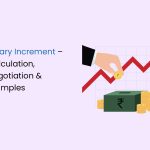A salary breakup structure, also known as a CTC (cost-to-company) breakup structure, is a comprehensive breakdown of the various components that constitute the total compensation offered to an employee. This structured format allows both employers and employees to understand how the total cost to the company is distributed across different elements, contributing to a clear picture of the overall compensation package.
This article covers all aspects of a salary breakup. Let’s dive in.
What is a Salary Breakup?
The salary breakup structure, or CTC breakup structure, delineates the allocation of the CTC into distinct components, offering insights into the in-hand salary of an employee.
While the CTC, or cost-to-company, represents the total salary package presented to an employee during the recruitment process, it’s important to clarify that the CTC does not equate to the monthly take-home pay. Instead, CTC encompasses the entire expenditure incurred by the company on an employee, incorporating various elements such as basic pay, provident fund, allowances, and more.
Companies may compute CTC by adding the employer’s contributions to the provident fund (PF) and gratuity to the gross salary, providing a holistic view of the overall financial commitment made by the organisation towards the employee. Understanding the components within the salary breakup structure is crucial for employers and employees to appreciate the comprehensive nature of the compensation package.
Components of a Salary Breakup Structure
Various components of salary breakup contribute to an employee’s overall compensation package. Understanding these components is crucial for employers and employees to appreciate the intricacies of the salary breakup. Here is a detailed exploration:
Basic Salary
Basic salary is the fundamental component of salary breakup, constitutes the fixed portion of the salary without factoring in benefits and privileges. Typically representing (30-50%) of the CTC. It is fully taxable, keeping it high will increase tax and PF liabilities, and keeping it low can make it fall under the minimum wage.
Allowances
Allowances encompass the expenditures borne by the employer to facilitate an employee’s required services. Varied and dependent on factors such as location, designation, and job role, allowances, including House Rent Allowance, Leave Travel Allowance, Conveyance Allowances, and Special Allowances, are provided in addition to the basic salary. The specific amount of allowances is influenced by the company’s individual policies.
Statutory Bonus or Performance Bonus
To acknowledge exceptional performance, the company may provide a statutory bonus in addition to the basic salary. Governed by the Payment of Bonus Act of 1965, this bonus is typically expressed as a percentage of the basic pay.
Employee Provident Fund (EPF or PF)
The Employee Provident Fund serves as a retirement benefit, with both the employee and employer contributing a designated percentage monthly. This amount, usually calculated at 12% of the basic salary, forms a savings fund accessible to the employee after one month of unemployment.
Gratuity
Gratuity is a lump sum amount awarded to employees as a gesture of gratitude after completing five years of service. Governed by the Payment of Gratuity Act of 1972, the calculation is typically set at 4.81% of the basic pay.
Insurance
Many companies extend group or individual life health insurance policies to prioritise the health and well-being of their employees. A nominal deduction from the CTC is allocated monthly to cover the premium payment.
Taxes and Liabilities
Following deductions for allowances, PF, gratuity, and bonus, the remaining amount undergoes adjustments for income tax and professional tax. Calculated based on applicable slab rates, employees can opt between the new and old tax regimes. The employer withholds the deducted amount, known as TDS (Tax Deducted at Source), before crediting the salary.
Gross Salary
Gross salary encompasses the total salary, including basic salary, House Rent Allowance, bonus, and various allowances, before any deductions.
In-hand or Take-Home Salary
The ultimate sum credited to employees’ bank accounts after all adjustments constitute the in-hand or take-home salary. This is the tangible amount received by employees at the end of every month, reflecting the culmination of the salary structure adjustments.
A simple formula is there to help in calculating your in-hand salary:
Net Salary = Basic Salary + Allowances – (Provident fund + ESI + Gratuity + TDS + LWF + Professional Tax)
How is Salary Determined?
The determination of an individual’s salary structure is a nuanced process influenced by a combination of factors, ensuring a personalised and equitable compensation arrangement. Key considerations include:
- Education Level and Experience: The educational background and professional experience of an employee play a pivotal role in shaping their salary structure. Advanced degrees or extensive experience may contribute to higher compensation.
- Industry and Job Significance: The industry in which an employee works and the significance of their role within that industry are crucial factors. Positions with greater responsibilities and impact may command a higher salary.
- Job Location and Cost of Living: The geographical location of the job is a significant determinant. Salaries are often adjusted based on the cost of living in the city or region. Jobs in high-cost areas may attract higher compensation to accommodate living expenses.
- Skill Sets and Demand: The specific skills possessed by an employee and the demand for those skills in the market influence salary structures. Specialised skills that are in high demand may lead to more competitive compensation packages.
- Talent Supply and Demand: The overall supply and demand for talent in a particular area or industry impact salary structures. Scarcity of certain skills may drive higher salaries to attract and retain qualified professionals.
In essence, salary structures are dynamic and responsive to each individual’s unique attributes and market conditions. Employers strive to create compensation packages that reflect employees’ value while considering external factors such as industry norms and regional economic conditions.
Salary Calculation Process
Step 1: Calculate Gross Salary
Gross Salary is derived by subtracting EPF (Employee Provident Fund) and Gratuity from the CTC (Cost to Company). This step establishes the baseline for further calculations.
Gross Salary = CTC – (EPF + ESI + Gratuity)
Step 2: Calculate Taxable Income
Taxable income is computed by deducting allowances, medical bills, professional taxes, insurance, and other deductions from the gross salary. Various income sources, including salary, house property, business profits, capital gains, and others, are considered in this step.
Taxable Income = Income (Gross Salary + Other Income) – Deductions
Allowances, Deductions, and Tax Calculation
- HRA (House Rent Allowance): Determine the HRA as the lowest of total HRA received, actual rent paid minus 10% of basic salary, or 50% (metro) or 40% (non-metro) of annual basic salary.
- Standard Deduction: Introduced in Budget 2019, this deduction is INR 50,000 annually.
- LTA (Leave Travel Allowance): Claimable twice in four years, covering domestic travel, subject to actual bills.
- Deductions (Section 80C, 80TTA, 80G, etc.): Various deductions with varying limits based on their nature.
Step 3: Calculate Income Tax
Refer to the income tax slab for the fiscal year to calculate income tax based on taxable income. Consider applicable slabs, rates, and surcharges.
Income Tax Slabs for FY 2019-20 (below 60 years)
| Net Income | Income Tax | Health and Education Cess |
|---|---|---|
| Up to Rs. 5 Lac | Nil | Nil |
| Rs. 5 Lac – Rs. 10 Lac | Rs. 12,500 + 20% on income above Rs. 5 Lac | 4% of income tax |
| Above Rs. 10 Lac | Rs. 1,12,500 + 30% on income above Rs. 10 Lac | 4% of income tax |
(Surcharge applies for income between Rs. 50 Lac to Rs. 1 Crore @10%, and above Rs. 1 Crore @15%)
Step 4: Calculate Net Salary
Net Salary is found by subtracting Income Tax and Employer’s PF Contribution from the sum of Basic Salary, Actual HRA, and Special Allowance. This is the amount an employee receives in their bank account.
Net Salary= Basic Salary + Actual HRA + Special Allowance – Income Tax – Employer’s PF Contribution (EPF)
Example: Calculating Take-Home Salary
Let’s consider the example of Karan, whose CTC is Rs. 16,00,000. Here are the details of her salary components:
| Salary Components | Amount (Annual) | Amount (Monthly) |
|---|---|---|
| CTC | Rs. 16,00,000 | – |
| Basic | Rs. 6,40,000 | Rs. 53,332 |
| HRA | Rs. 3,20,000 | Rs. 26,666 |
| EPF | Rs. 21,600 | Rs. 1,800 |
| Sec 80C Investment | Rs. 1,00,000 | Rs. 8,333 |
| Leave Travel Allowance | Rs. 20,000 | Rs. 1,666 |
| Special Allowance | Rs. 5,75,324 | Rs. 47,943 |
| Gratuity | Rs. 23,076 | Rs. 1,923 |
| Professional Tax | Rs. 2,400 | Rs. 200 |
Note: Karan can decide how much she wants to invest and claim under section 80C, with the maximum deduction being Rs. 1,50,000. EPF amount also comes under section 80C.
Now, let’s calculate Karan’s take-home salary:
Step 1: Calculating Gross Salary
- Gross Salary=CTC−(EPF+Gratuity)
- Gross Salary=INR 16,00,000−(INR 21,600+INR 23,076)
- Gross Salary=INR 15,55,324
Step 2: Calculating Taxable Income
First, calculate the HRA deduction that can be claimed:
- HRA that can be claimed = Minimum of (Actual HRA, Rent paid−10% of basic, 50% of Basic for the metro city)
- HRA that can be claimed=Minimum of (INR 3,20,000, INR 3,60,000−10% of INR 6,40,000, 50% of INR 6,40,000)
- HRA that can be claimed=INR 2,96,000
- Taxable Income=Gross Salary−Section 80C deduction−Standard
- Deduction−HRA−Professional Tax
- Taxable Income=INR 15,55,324−INR 1,00,000−INR 50,000−INR 2,96,000−INR 2,400
- Taxable Income=INR 11,06,924
Step 3: Calculate Income Tax
Based on the slab rates announced in the FY 2019-20:
- Income Tax=INR 1,12,500+30% of (Taxable Income−INR 1,00,000)
- Income Tax=INR 1,12,500+30% of (INR 1,06,924)
- Income Tax=INR 1,87,347
- Cess=4% of Income Tax
- Net Tax=INR 1,87,347+4% of INR 1,87,347
- Net Tax=INR 1,94,841
Step 4: Calculating Net Salary
- Net Salary=Gross Salary−(Income Tax+Professional Tax)
- Net Salary=INR 15,55,324−(INR 1,94,841+INR 2,400)
- Net Salary (Annual)=INR 13,58,540
- Net Salary (Monthly)=INR 1,13,212





















